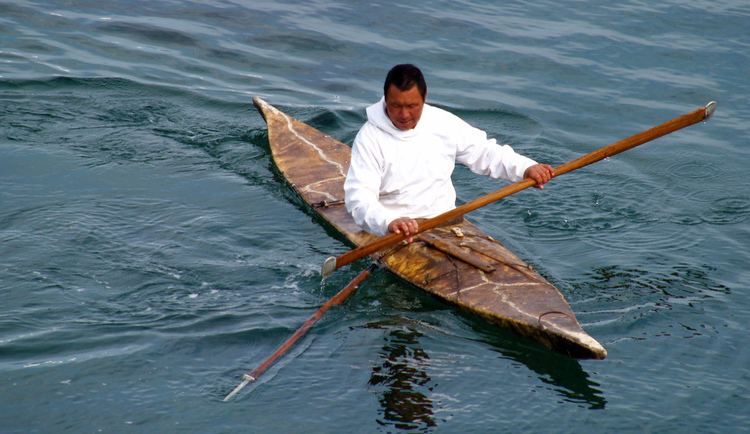Greenland ≈50,000 United States 352 Faroe Islands 163 | Denmark ≈20,000 Norway 293 Iceland 65 | |
 | ||
Greenlanders or Greenlandic Inuit (Greenlandic: kalaallit) are the indigenous peoples of Greenland and citizens of Denmark, most of whom speak Greenlandic and consider themselves to be of Greenlandic ethnicity.
Contents
Approximately 89% of Greenland's population of 57,695 is Greenlandic Inuit, or 51,349 people as of 2012. Ethnographically, they consist of three major groups:
Historically, Kalaallit referred specifically to the people of Western Greenland. Northern and Eastern Greenlanders call themselves Avanersuarmiut and Tunumiit, respectively.
Today, most Greenlanders are bilingual speakers of Kalaallisut and Danish and most trace their lineage to the original founding ancestors of Greenland. Vast majority of ethnic Greenlanders reside in either their native country or elsewhere in the Danish Realm, primarily Denmark proper (approximately 20,000 Greenlanders reside in Denmark proper). There are few Greenlanders who are multiracial, mostly due to Danish colonists and other Europeans marrying into indigenous families.
Regions
The Greenlandic people are considered to be descended from Dorset and Thule people, who settled Greenland in ancient times. As 84% of Greenland's land mass is covered by the Greenland ice sheet, Inuit people live in three regions: Polar, Eastern, and Western. In the 1850s, additional Canadian Inuit joined the Polar Inuit communities.
The Eastern Inuit, or Tunumiit, live in the area with the mildest climate, a territory called Tunu or Tasiilaq. Hunters can hunt marine mammals from kayaks throughout the year.
Language
Kalaallisut is the standard language of Greenland. It is the western variety of the Greenlandic language, which is one of the Inuit languages within the Eskimo-Aleut family. Kalaallisut is taught in schools and used widely in Greenlandic media.
History
Humans are thought to have arrived in Greenland, possibly from Ellesmere Island, around 3000–2500 BCE. Other researchers believe the first humans in Greenland were members of the Saqqaq culture who migrated to western Greenland from Northern Canada around 2500 BCE. Saqqaq people are unrelated to contemporary Greenlandic Inuit people. They survived until 800 BCE.
Around 1000 BCE, people from the Dorset culture settled in Greenland. The Dorset flourished in Greenland from 600 BCE to 200 CE.
The Thule people began colonizing Greenland from the northwest about 900. Norse colonization began shortly thereafter in 982 and lasted a few centuries; sagas refer to the locals as skrælings and the Greenlandic ethnonym Kalaalleq may be based on the word skræling, but the origin of the word is uncertain. William Thalbitzer (1932: 14) speculates that skræling might have been derived from the Norse verb skråla, meaning "bawl, shout, or yell". An etymology by Michael Fortescue et al. (1994) proposes that the Icelandic word skrælingi may be related to the word "skrá", meaning "dried skin", in reference to the animal pelts worn by the Inuit. The term is moderately pejorative in the Saga of Erik the Red as it is first used after a negative description of Native Newfoundlanders encountered in Vinland. First Nations people in Canada consider it offensive.
European visitors to Northeast Greenland before the early 19th century reported evidence of extensive Inuit settlement in the region although they encountered no humans. In 1823, Douglas Charles Clavering met a group of twelve Inuit in Clavering Island. Later expeditions, starting with the Second German North Polar Expedition in 1869, found the remains of many former settlements, but the population had apparently died out during the intervening years.
Denmark–Norway passively maintained a claim to Greenland until 1721, when it resumed possession of the territory. In 1814, possession was awarded to Denmark by the Treaty of Kiel. In 1979, the Greenlanders voted to become autonomous. There is an active independence movement.
Society
Gender roles among Greenlandic Inuit are flexible; however, traditionally men hunt and women prepare the meat and skins. Most marriages are by choice, as opposed to arranged, and monogamy is commonplace. Extended families are extremely important to Inuit society.
Art
The Greenlandic Inuit have a strong artistic tradition based on sewing animal skins and making masks. They are also known for an art form of figures called tupilaq or "evil spirit objects". Traditional art-making practices thrive in the Ammassalik. Sperm whale ivory remains a valued medium for carving.
Ammassalik wooden maps are carved maps of the Greenlandic coastline, used in the late 19th century.
